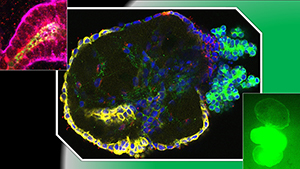
Study illuminates sugar’s role in common kidney disease
A study of kidney organoids in a novel lab environment might have downstream implications for the treatment of polycystic kidney disease (PKD), an incurable condition that affects more than 12 million people worldwide.
One key discovery of the study: Sugar appears to play a role in the formation of fluid-filled cysts that are PKD’s hallmark. In people, these cysts grow big enough to impair kidney function and ultimately cause the organs to fail, necessitating dialysis therapy or transplant.
The findings were published Dec. 23 in Nature Communications. Co-lead authors are Sienna Li and Ramila Gulieva, research scientists in the lab of Benjamin Freedman, a nephrology investigator at the University of Washington School of Medicine.
“Sugar uptake is something that kidneys do all the time,” said Freedman, a co-senior author. “We found that increasing the levels of sugar in the dish cultures caused cysts to swell. And when we employed drugs known to block sugar absorption in the kidneys, it blocked this swelling. But I think it relates less to blood sugar level and more to how kidney cells take in sugar — which in this process seemed to go rogue and give rise to cysts.”